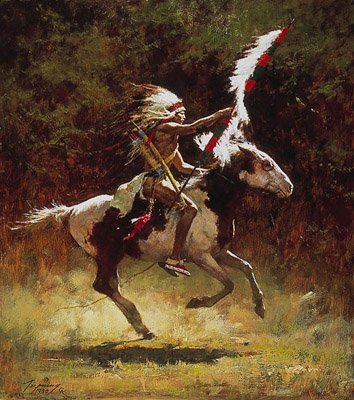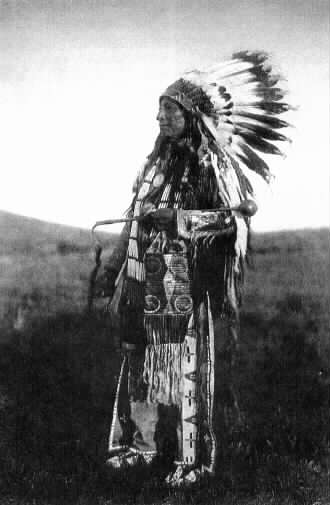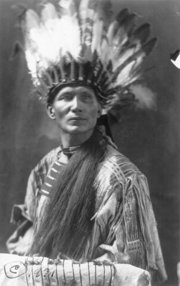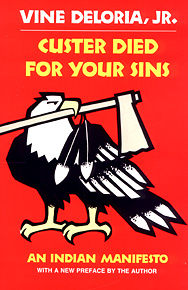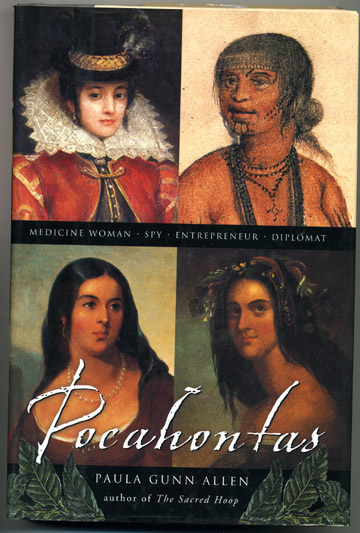LITR 5731 Seminar in American
Multicultural Literature
Minority Literature

Lecture Notes
conclude Black Elk Speaks
|
announcements Sioux poetry: Gary Pegoda midterms > research proposals web highlight: Sonya Prince instructor's questions for Black Elk assign Love Medicine |
|
Thursday, 4 October: Black Elk Speaks: chapters VII-XIII (pp. 92-161); chapter XVII-end including appendices (pp. 194-298); selections from The Black Elk Reader (handout)
Web highlight (research projects): Sonya Prince
Poetry: Peter Blue Cloud, "Crazy Horse Monument"
Poetry reader / discussion leader: Gary Pegoda
page numbers may differ
appendices--information about Neihardt's development of material
Continue question on Romanticizing of American Indian
Thursday, 11 October: Provisional Research proposal due. Love Medicine through “A Bridge” (ends on p. 180)
Discussion-starter: Jennifer Rieck
Web-highlight (research projects): Patricia (Pat) Dixon
Thursday, 18 October: Love Medicine (complete)
Discussion-starter: Kathleen Anderson
Web highlight (research projects): Jennifer Jones
Poetry: Louise Erdrich, “Indian Boarding School: The Runaways”
Poetry reader / discussion leader: Kathleen Anderson
announcements
This weekend in Galveston: Friends of Rosenberg Library Book Sale
Friday evening: members only
Saturday 10-5, Sunday noon-3
University of Houston-Clear Lake

Mark your calendars for April 16-18, 2008
The 14th Annual Student Conference for Research and Creative Arts will be at UHCL on April 16-18, 2008. The conference is open to all students – undergraduate and graduate – from all disciplines.
Look for the Call for Papers in your box in October.
We are asking the faculty to encourage students to present their scholarly papers, empirical research, and projects.
We will be happy to arrange a brief presentation to your classes. If you are interested, please contact us.
If you have suggestions for making this the best conference ever, or if you have questions, please contact one of us. Check the website (link below) for details.
Michael Hunt, ex. 3375
Pilar Goyarzu, ex. 3398
Andrew Reitberger
Conference Directors
Dr. David Malin
Faculty Liaison
http://www.uhcl.edu/ResearchArtsConference/
Introduce Black Elk Speaks
Black Elk an Oglala Sioux
Sioux among most important Indian peoples in American imagination, history, and literature
Sioux = collection of related language-culture groups--Oglala, Teton, etc.
Lewis & Clark expedition (1802-5) records much early knowledge of Sioux peoples
Imagination:
|
|
|
Great Sioux leaders include Sitting Bull, Red Cloud, and Crazy Horse.
Their outstanding literary figures include
Black Elk
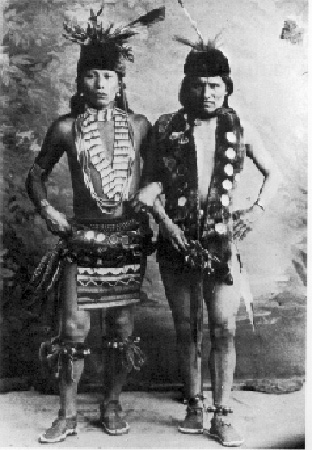
Zitkala-Sa (Gertrude Bonnin)
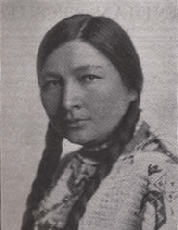
Dr. Charles Eastman
|
|
|
Vine Deloria Jr.
|
|
|
Paula Gunn Allen.
|
|
|
assign Love Medicine
Thursday, 11 October: Provisional Research proposal due. Love Medicine through “A Bridge” (ends on p. 180)
Discussion-starter: Jennifer Rieck
Web-highlight (research projects): Patricia (Pat) Dixon
Black Elk Speaks 1932; Love Medicine 1984, 1993
Continuities with Black Elk? What has changed about American Indian literature?
If Black Elk and Love Medicine are both examples of Native American literature, how do you talk about them together?
3b. Native American Indian alternative narrative: "Loss and Survival"
(Whereas immigrants define themselves by leaving the past behind in order to become American, the Indians were once “the Americans” but lost most of their land along with many of their people. Yet Native Americans defy the myth of "the vanishing Indian," choosing to "survive," sometimes in faith that the dominant culture will eventually destroy itself, and the forests and buffalo will return.)
Romanticization of Indian? or post-modern substitutes for Romanticism?
Evaluate description:
Erdrich as part of wave of recent ethnic women writers who balance wide popularity with critical respectability
How?
What resemblances to popular + critically praised African American and Mexican American women writers (e. g. Maya Angelou, Sandra Cisneros)
"friendlier" writer than Morrison, but less profound--but pleasantly profound--how?
instructor's questions
Questions may be answered in any order.
Does Black Elk Speaks romanticize American Indians? How?
What does "romanticize" mean?
Who is the author of the text? What's at stake?
How would recent theories of "the death of the author" help resolve this question?
How does extra-textual information (such as Black Elk's Catholicism) affect the text or its reading?
How much do these issues impact the "assimilation-resistance" conflict in minority literature? Does Native American literature / culture offer alternatives to these extremes of cross-cultural interaction?
instructor's answers:
Does Black Elk Speaks romanticize American Indians? How?
What does "romanticize" mean?
noble savage theme < Rousseau
"close to nature"
nostalgia for lost world of innocence, organic relations
imposition of Genesis / Eden story on cultural / personal history
How much do these issues impact the "assimilation-resistance" conflict in minority literature? Does Native American literature / culture offer alternatives to these extremes of cross-cultural interaction?
"acculturation"
"syncretism"
American Indians offer yet another option--a variant on assimilation that's sometimes called "acculturation." This is a form of change that's peculiar to traditional societies like Native America.
Broad distinction:
Assimilation: person or group gives up old culture to adapt to new culture; compare "conversion," where you give up old ways for new ones
Acculturation: old culture absorbs new items or ideas, incorporates them to pre-existing culture.
Example of American Indian acculturation: horses
Assimilation is more radical, revolutionary, more rapid and unsettling change.
Acculturation is more gradual--something relatively new can look like it's been there forever.
Examples of acculturation in Black Elk?
3b. Native American Indian alternative narrative: "Loss and Survival"
(Whereas immigrants define themselves by leaving the past behind in order to become American, the Indians were once “the Americans” but lost most of their land along with many of their people. Yet Native Americans defy the myth of "the vanishing Indian," choosing to "survive," sometimes in faith that the dominant culture will eventually destroy itself, and the forests and buffalo will return.)
syncretism
Originally a political term, 'syncretism' was used to describe the joining together of rival Greek forces on the Isle of Crete in opposition to a common enemy."
SYNCRETISM.... a "churchy" word, meaning "the mixing or blending together of various religious beliefs and traditions". I recently heard this word on a TV news program.... and I was stunned and fascinated to learn its definition.... and its "religious" implication
(http://www.terrific-tabs.com/print_syncretism.htm)
Syncretism
From Wikipedia, the free encyclopedia.
Syncretism is the belief in the mixing of various schools of thought. It is especially associated with the attempt to merge, analogize or assert the underlying unity of several originally discrete traditions, especially in religion and mythology.
Syncretism is common in literature, music, representational art and other expressions of culture. . . .
More recent religious systems that exhibit marked syncretism include Vodun and Santeria, which analogize various Yoruba and other African gods to the Roman Catholic pantheon of saints. The larger, major world religions also have exhibited degrees of syncretism. For example, pagan Yule traditions were adopted by Christianity into its Christmas celebrations, and Roman Catholicism in Central and South America integrates a number of elements derived from indigenous cultures in those areas.
from Wikipedia: http://en.wikipedia.org/wiki/Syncretism
lots of examples in Mexican American literature, especially meetings between Indian magic and Catholic religion > Bless Me, Ultima
African American: call-and-response group-vocal technique adapts to Christianity with sermon style, spirituals
White evangelical churches with American flags up front
American Indian creation story, "How America was Discovered" mixes "Great Spirit" with "Son" and Columbus
Black Elk Speaks as Indian + Christian?
survival technique?
violation of Romantic purity?
midterms > research proposals
nearly finished reading
seminar has personality, seriousness, sense of opportunity
Returned this weekend?
Welcome to reply, etc.
Due date for research proposal--technically, Oct. 11
Practically, more casual deadline--I should hear from you within a week of Oct. 11
reason: research project highly individualized--need to accommodate personal crises, perplexities, latencies, commitment issues
either a proposal or discussion toward a proposal
As with midterm, the only real problem is if I have to ask you . . . .
Research project:
Provisional research proposal due by email 11 October
(Length: 3-4 paragraphs)
Research Project due 29 November
Length: 12-20 pages; Weight: 35-40% of final grade.
Research Project options: paper or journal
You have considerable freedom to develop your research project according to your own needs. The standard options for this project are a traditional research or term paper, or a research journal. Both options will be graded by similar categories, including depth and expertise in research, and quality of writing, including readability and interest.
Provisional research proposal (due 11 October, ungraded): Email 3 or 4 paragraphs plus or minus any outlines or bibliographies. Indicate which option—paper or journal—you're choosing. End your proposal by asking me a question or questions about your topic or your plan of action.
· If the essay option, describe the topic you are planning for your essay. Indicate which texts you will use. You may indicate two or three topics if you are still trying to make up your mind.
· If the journal option, survey the range of possible contents or subjects that you may cover, plus any unifying theme or direction for the journal.
· You may change your option or topic as your research and writing progress. If the change is "natural" and still falls generally within the description of your original proposal, you do not need to submit another proposal. If, however, you change your option or topic completely, please submit another proposal.
· More details on each option follow below.
Most important consideration: make the course requirements work for you
Potential chapter for thesis, development of subject--turn toward your interests and purposes in pursuing an M.A.
Other consideration: traditional essay-style term paper, or research journal?
Journal assignment is flexible but rigorous
For sense of range, see Model Assignments
essay = thematic analysis of texts
journal = knowledge-gathering, organization of findings & report on learning
leftover notes from previous offerings
Roxane Richter
Discussion Leader
March 7, 2006
Objective 7:
To survey minority
representations of the dominant culture
~~
In Black Elk Speaks, Black Elk refers to the white people he sees coming into his land as “Wasichu” = white people, also, something holy, incomprehensible (appendix 3, page 223).
Black Elk sees the white people first as invaders on the Lakota’s land, then as greedy, lying people who kill innocent women & children, and finally, as people who cannot be trusted and break their vows and agreements.
Killing of Innocents: (pg. 96): “Those Wasichus had come to kill our mothers & fathers and us, and it was our country.”
Lying: (pg. 107): “It was a story the Wasichus told, and their tongues were forked when they told it.” [After the killing of Crazy Horse, the soldiers said they would remain unharmed if they returned peacefully to the camp]
(pg. 102): “…the Wasichus had made a
treaty with Red Cloud, that said it [the
land] would be ours as long as grass would grow and water flow. That was only
eight winters ago, and they were chasing us now because we remembered and they
forgot.”
(pg. 109): “They could not kill him [Crazy Horse] in battle. So they had to lie to him & kill him that way.”
Incomprehensible: (pg. 108): “My father is with me, and there is no Great Father between me and the Great Spirit.” [President of U.S.]
(pg. 102): “Wherever we went, the soldiers came to kill us, and it was all our own country.”
7b.) To
observe shifting names or identities of the dominant culture in relation to the
minority culture
As for the change of the definition of “Wasichu” name over time, I found an
excerpt from a book entitled: Wasi'chu, The Continuing Indian Wars by Bruce Johansen and Robert Maestas:
”The Lakota also used the
metaphor to describe the newcomers. It was Wasi'chu, which means "takes the
fat" or "greedy person." Within the modern Indian movement,
Wasi'chu has come to mean those corporations and individuals, with their
governmental accomplices, which continue to covet Indian lives, land, and
resources for private profit. Wasi'chu does not describe a race; it describes
a state of mind. Wasi'chu is also a
human condition based on inhumanity, racism, and exploitation. It is a sickness,
a seemingly incurable and contagious disease which begot the ever advancing
society of the West”
~~
The northern plains native Americans called
themselves "Lakota," meaning "the people,"
a word that provides the semantic basis for Dakota, but the first European
people to meet the Lakota called them "Sioux" (a
contraction of Nadowessioux = now-archaic French-Canadian word) meaning "snake"
or enemy, according to Johansen.
QUESTION::::::
How have minorities changed the names and definitions, descriptions of
Americans in the past decade(s)? And vice versa? What are some factors that
caused such a dramatic turnabout?
7a.)
Primary definition of the “American dream” or “Immigrant culture”
The differences between the dominant “American
Dream” and the minority Lakota dream/utopia (“Loss and Survival”
narrative) are vast, based primarily on the large chasm of differences in
values, religion and family orientation. Although, admittedly, there are
astonishing similarities (Ross Enochs, page 282) between Catholicism and Lakota
beliefs, including:
q
Helper spirit (Lakota) or
guardian Angel/ Mother Mary (Catholics) to give assistance & to whom they
could pray;
q
Atonement for misdeeds
(Lakota); Penance for sins (Catholics);
q
Rituals ordered and
channeled sacred power and made it usable;
q
Prayers & ceremonies
(done by living) impact destiny of dead;
q
Road to salvation is
through works and faith; and
q
Sacrifice was key to both
– a flesh and blood in the Sun Dance; Christ as a sacrifice.
But while he may have understood some of the white
people’s faith beliefs, the “American Dream” was one Black Elk could not
comprehend. He could not grasp why the Waischus would want to try to obtain some
permanent “ownership” pieces of nature (yellow metal that made them
crazy”) and land that was there before they were born, and would be there long
after their death. The Lakotas
understood that the natural world was there to be used by them as temporary
keepers of the animals, land and plants. They
considered their “dream” to be based in a (balanced) natural world, with its
wildlife and forces as sacred divinities: “…as long as the hoop was
unbroken, the people flourished. The flowering tree was the living center of the
hoop, and the circle of four quarters nourished it. The east gave peace and
light, the south gave warmth, the west gave rain and the north with its cold and
might wind gave strength and endurance” (pg. 150).
Lakota Vision:
(pg.92) “The earth is all that lasts!”
(pg. 111): “It does not matter his body lies,
for it is grass; but where his [Crazy Horse] spirit is, it will be good
to be.”
(pg. 134):“…he lit it [sacred pipe] and
offered it the Powers of the World…”
(pg. 150): “The Power of the World always works
in circles.”
(pg. 141): “…I thought it might be better if
my crying would kill me; then I could be in the outer world where nothing is
ever in despair.”
(pg. 151): “We are prisoners of war while we are
waiting here. But there is another world.”
(pg. 158): “To use the power of the bison/elk, I
had to perform that part of my vision…”
QUESTION::::::
What are some of the differences between Catholicism & the Lakota
beliefs?
QUESTION::::::
Read the last two paragraphs on page 207. “A people’s dream died there. It
was beautiful dream.” The Native American dream is based on waiting, a “loss
and survival”narrative – So is all lost? Is the “hoop” forever broken?
Why?
~~ END ~~
